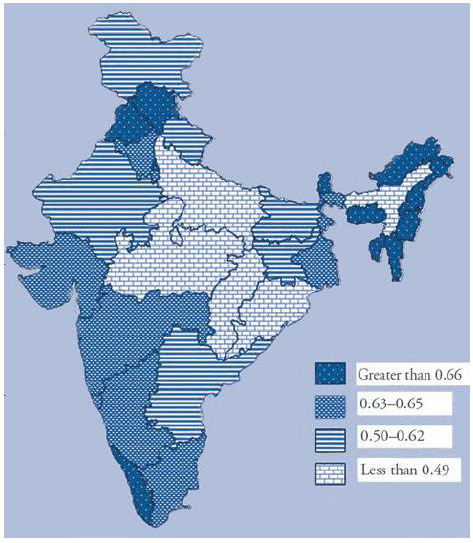1.5.4. Health Index
The Health Index is defined in terms of life expectancy at birth since a higher life expectancy at birth reflects better health outcomes for an individual.

Figure 7. Health Index across states
The improvement in the Health Index for India between 1999–2000 and 2007–8 was much lower than both the Income Index and the Education Index. The improvement in the Health Index during the period 1999–2000 to 2007–8 (13 per cent) is well below the improvement in the overall HDI of the country. In other words, while the Income Index has improved at the same rate as the HDI, and the Education Index by much more than the improvement in the HDI, the Health Index has not shown any significant change.
There are already well-known cases of success in building an effective public health system in several states of India (for example, Kerala and Tamil Nadu). With the best public health system in the country Kerala has the highest life expectancy at birth. What is worth mentioning is that Bihar, the state that ranks the lowest in terms of almost all human development indicators, has a life expectancy at birth at par with the national average. Similarly, the relatively poorer state of Rajasthan performs marginally better than the national average. The north-eastern states, excluding Assam, have a higher life expectancy at birth compared to the national average.
It is the states with the most serious health outcome indicators and the worst health process/input indicators, which have shown the most improvement over this period, namely, Madhya Pradesh, Uttar Pradesh, Orissa, and Assam.
Overall the states’ policies play a crucial role in shaping the nature of the development process. How inclusive the development process is for all the social groups residing in the state is a reflection of the state’s commitment towards various dimensions of human welfare. This is supported by the success of social mobilization states like Tamil Nadu, Kerala, and the north- eastern states, where strong state commitment resulted in the upliftment of the backward castes such that their performance in health and education indicators is even better than the upper castes in most of the other states.
